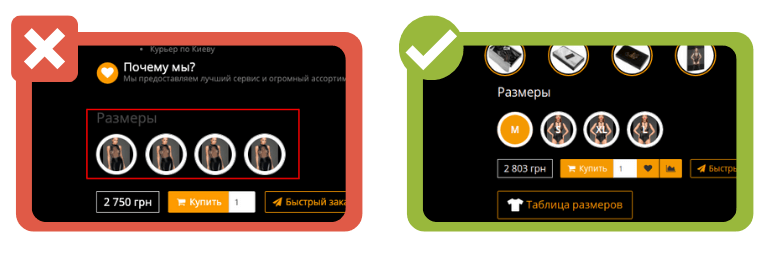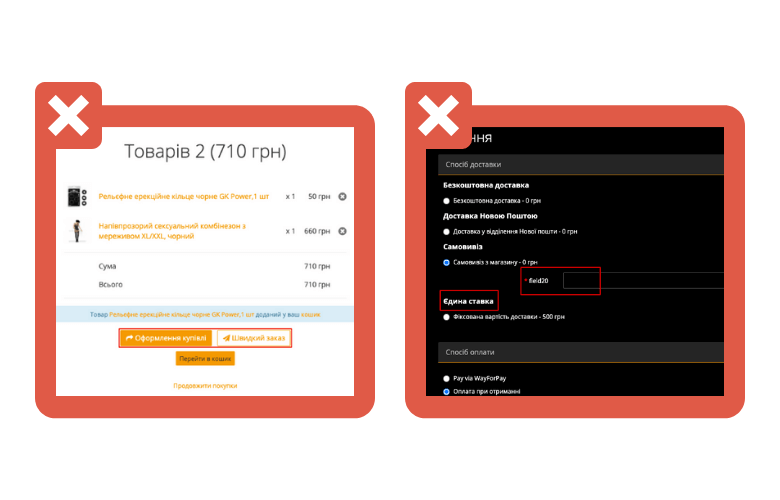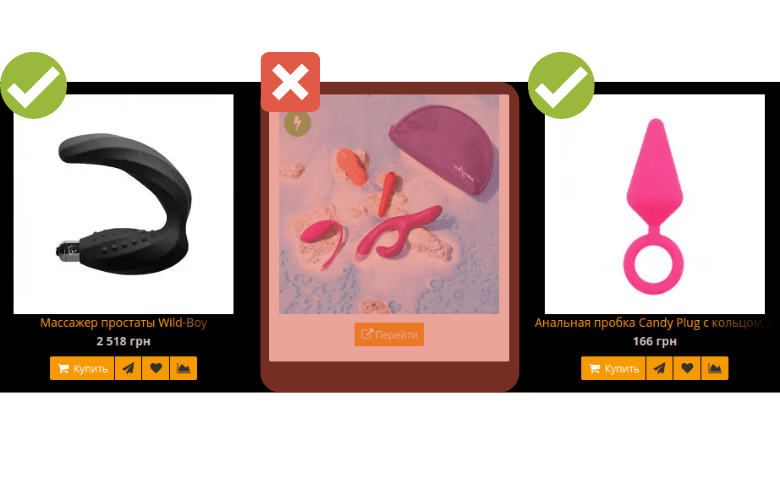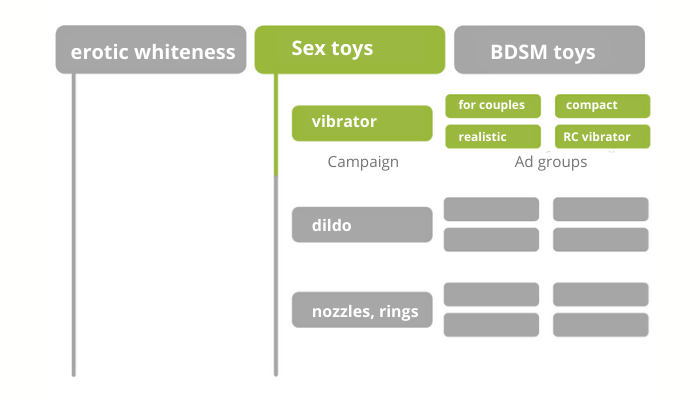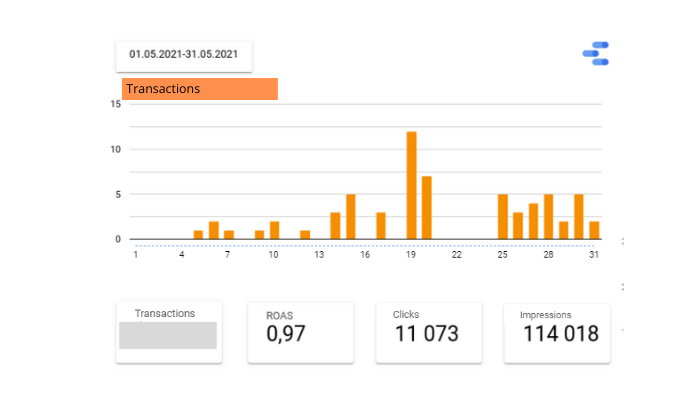Client
Online store of goods for adults Sex Is Good.
Positioning: quality sex toys at affordable prices.
The main feature: the date of the online store launch was the same as the date of the work start. Respectively, the responsibility was twice as high since the client entrusted us with a “newborn” business.
Before getting straight to the point, it is important to mention some of the aspects that make sex shop promotion different from any other e-commerce project.
- Google Ads has restrictions on the promotion of products for adults (details are described in the reference).
Without going into lengthy explanations, the only available format of work is search ads.
This means that the launch of a new online store had to be:
- without remarketing (Google’s restriction on collecting personalized audiences);
- without KMS;
- without Shopping campaigns*;
- without TruView for Action;
- without discovery.
*Today, we have found a solution — our team is testing it.
-
High, no, very high level of competition.
Below we present data on auction statistics for the first month of the activity of the Republic of Kazakhstan, with an impressive advertising budget. And we got less than 25% impressions.
-
A large number of fake orders.
Since sex toys are still widely regarded as something shameful and perverted in society, immature teenage (and sometimes not teenage!) minds play pranks by leaving orders at an adult store with a friend’s number.
At this point, we consider the retreat is completed. Now, with more understandable niche specifics, the reading process will become more exciting for you.
Work Period
We carried out active work on the project from 01.05.2021 to 30.11.2021.
To evaluate the effectiveness of the work carried out in dynamics, we will compare the results of the first and last maintenance periods:
- First full maintenance period
01.05.2021-31.05.2021 - Last (at the time of case writing) full period of maintenance
01.11.2021-30.11.2021
The goal of the project announced at the beginning of cooperation was
to get the maximum possible number of transactions within a fixed budget for clicks.
Stages of Work
Express audit of the site in terms of UI/UX and readiness of the resource to receive commercial traffic.
On projects with a history, auditing is much easier, since recommendations for implementing changes can be backed up with actual data from Google Analytics. After implementation is completed, the effect can be evaluated. Since the sexgood.com.ua domain had no history at the start of work and our recommendations could not be backed up with statistics, our team postponed the implementation of some changes. The client’s decision not to implement all the recommendations at the start of the project was quite understandable and logical, since the project was launched from scratch, and unforeseen expenses could significantly delay the moment of its reaching self-sufficiency.
-
Basic UX/UI errors were identified on the site:
Inconvenience in using the size selection element in the product card. In the basic version, the size of the product was not visible and the letter designation (S/M/L/XL) was not indicated on the size selection elements.
- Language versions errors were incorrect translation of navigation elements, notifications of forms submissions.
-
Technical errors were displaying code snippets and incorrect elements.
Sexshop Promotion Strategy Using Google Ads, the First Period of Work on Setting up and Optimizing Campaigns.
Having compared the input data and wishes of the client, the specifics of the niche and the experience of the project team (PPC-specialist, project manager, technical leader), we outlined and fixed the main points, on the basis of which we subsequently took all actions on the project:
- quick start of all categories;
- the account must have a logical structure in order to minimize the time spent on campaign management (it is important with 14,000+ product items and the inability to launch a shopping campaign);
- absence of priority in categories or products;
- maximum of campaigns effectiveness;
- emphasis on automation.
In the First Period, our Specialists:
- set up 9 campaigns: 7 with search ad groups (expanded and adaptive), keyword grouping by STAG (Single Theme Ad Groups — a way to group keywords based on the principle of thematic identity) and DSA groups (Dynamic Search Ads — type of ads on search, in which titles and the final URL are generated automatically based on the content of the site); 1 campaign with DSA groups only, 1 “smart” campaign for general queries;
- prepared universal extensions for all campaigns (additional links, structured descriptions, clarifications, phone numbers);
- set up conversion tracking in Google Analytics;
- developed a strategy for setting up and launching product categories.
- The image below shows an example of a scheme for one of the categories:
Since it was necessary to launch all categories in a short time, we decided to build the account structure as follows:
-
in the first period: campaign = category on the site; ad group = subcategory on the site;
-
in the next periods, based on performance data, we displayed the subcategories with the best results in separate campaigns;
-
subcategories in individual campaigns were divided into groups by brand/purpose/material/popularity.
This structure applies to both standard search campaigns and DSA campaigns.
Results of the first promotion period 01.05.2021 — 31.05.2021 were as follows:
Key Aspects that Significantly Affect the Effectiveness of Contextual Advertising
Dynamics of the main indicators for the project for 6 months from the date of launch
-
June
-
The period of learning automatic strategies was ended;
-
search queries by expanding the lists of negative keywords were worked out ;
-
keywords with low performance were paused.
-
July
-
new ad groups for 7 subcategories were launched;
-
testing of ad formats (adaptive search, expanded text, with and without dynamic insertion, with USP for specific products and store USP, with and without price indication) were launched;
-
80% of campaigns were moved to the general budget with a target for a group of campaigns in the form of a target cost per conversion.
-
August
-
a branded advertising campaign was launched;
-
cross-minus settings were adjusted;
-
ad groups with a cost per transaction above (50%) the account average were paused;
-
new ad groups for 5 subcategories were launched;
-
ad texts were updated;
-
unique extensions for each product category were prepared.
-
September
-
campaigns for top brands by sales and client priority list were launched;
-
testing of automatic strategies (Maximum Conversions/Maximum Conversion Value/Target ROAS) was launched;
-
calltracking, reconciled Google Analytics and CRM data to determine the error rate for the indicators Income, Number of transactions, Average check were established;
-
changes to the logic of budget distribution, according to the data obtained as a result of reconciliation were made.
-
October
-
search queries by expanding the list of negative keywords were worked on;
-
an experiment with hybrid campaigns (by activating the Display Network Impressions feature for search campaigns) was launched;
-
an experiment using a broad keyword match type was run;
-
an internal audit of the account for previous periods was conducted. As a result, some subcategories with a low profitability indicator were suspended, and in the remaining subcategories they expanded the semantic core and increased budgets.
-
November
-
the targeting settings in DSA-groups were changed: categories sections were excluded, and targeting was set only to product cards;
-
ad text due to increasing deviations for “Birth Control” was updated;
-
the targets in campaigns with the strategies “Target CPA” and “Target ROI” were adjusted;
-
the semantic core in active campaigns was expanded.
The Results of the Last Full Promotion Period (at the time of case writing):
In 6 months of optimization, without increasing the budget for clicks, our team managed to achieve the following results:
-
increase the income of the online store by 6 times;
-
increase the number of transactions by 3.5 times;
-
bring profitability out of the negative indicator and increase ROAS by 5.5 times.
Summing up the interim results of the project, the team identified the main factors that made it possible to achieve such results, which are discussed below.
Client Interaction:
-
The client provided almost complete freedom of action in decision-making, which allowed it to reduce the period from the idea to the implementation of tests and experiments. As a result, the time that was usually spent on coordination and discussion, we spent on productive work;
-
we performed the prompt implementation of the necessary changes to the site, a connection of call tracking, feedback on the quality of leads — with the sexgood project, the process turned out to be as simple as possible: we need it — we do it;
-
the project was supplied by perfect teamwork, common goals for both teams, customer and contractor, both sides’ actions were fully coordinated.
Experiments and Tools:
-
the “Impressions on Display Network” feature for search campaigns allows you to reduce the cost per conversion, on average, by
15-18%; -
using a broad match type in conjunction with automatic strategies allows you to increase the number of conversions without increasing their cost (despite a significant layer of strange/irrelevant queries). The main difficulty is not to stop testing ahead of time. On the sexgood project, the first 2 weeks of testing with a wide keyword match type, advertising campaigns collected a huge number of impressions for junk queries (there were not so many clicks that it became critical in terms of costs), but after 14 days, the algorithm learned enough to discard non-targeted auctions — and we noticed a positive effect from the experiment;
-
Unique and relevant ads extensions for a category or a specific product increase the conversion rate. Texts must be prepared in such a way as to prevent the client’s questions about the product at the stage of the first touch;
-
the overall budget for campaigns and creating groups with a performance goal not only simplifies account management but also increases the effectiveness of automatic strategies;
-
Feeds with commercial data are a tool that can reduce the time spent on account management by at least 30%.
Project Participants:
-
Project Manager: Yulia Myrna
-
PPC-specialist: Oleksandr Shylin
-
Head of PPC department: Halyna Lyman.



